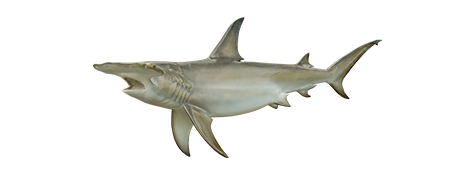Hammerhead Shark

Hammerhead shark heads are T-shaped and almost straight along the front edge and notched in the center.
HOW TO IDENTIFY A HAMMERHEAD SHARK
They eyes of these fish are located at the ends of two thin protrusions, resembling a hammer and the caudal peduncle lacks keels. Of the nine species of hammerhead sharks, the largest is the great hammerhead, which may reach a length of 20 feet. Another large species, the smooth hammerhead, grows to 14 feet. The front edge of its head is rounded and unnotched in the center. The scalloped hammerhead grows to 10 feet. The front edge of its head is rounded and notched. Of the lesser known hammerheads, there is S. couardi, a large West African species that resembles S. lewini, and the strange looking S. blochii, whose head lobes often measure 50 percent of the body length and are swept back like the wings of an airplane. The remainder of the species, known as the bonnetheads, are only 3-6 feet long and have very short lobed, shovel shaped heads.It swings its broad, flat head back and forth over the bottom in a scanning pattern, in the same way as one uses a metal detector. Tiny organs called the ampullae of Lorenzini, located in the hammerhead sharks’ head, function as electroreceptors that enable the shark to detect food buried beneath the sand. Stingrays are a favorite food of this species. According to scientist Perry Gilbert, one large hammerhead was found to have 96 stingray barbs imbedded in its jaw, mouth, and head.
WHERE TO CATCH HAMMERHEAD SHARK
The hammerheads occur worldwide, but some species have more restricted ranges. The most widely distributed species is probably the smooth or common hammerhead, Sphyrna zygaena. They inhabit shallow waters along the coasts, bays and harbors where the water is calm and the bottom sandy. The following list includes additional details on where to catch this fish:
BAITFISH PATCHES BIRDS
DEEP SHORE WATER REEFS, WRECKS, AND SHOALS
BAYS AND ESTUARIES COASTAL WATERS
NIGHT FISHING SURF AND SHORE
HOW TO CATCH HAMMERHEAD SHARK
When hooked, hammerheads fight hard making long surface and midwater runs while thrashing about causing a great deal of commotion. Fishing methods include slow trolling, drifting, or still fishing with chum and baits that are oily or bloody. Mackerel, jack, squid and other live, oily fish, as well as artificial lures, may also work on occasion. Most larger hammerheads are female specimens and anglers should think about releasing these fish before bringing fish of this size into a boat. The following are fishing methods used to catch this fish:
DRIFT FISHING SURF CASTING
SALTWATER TROLLING CHUMMING
STILL FISHING
HAMMERHEAD SHARK LURES, TACKLE & BAIT
The following are lures, tackle or bait that can be used to catch this fish:
CUT BAIT SQUID
SALTWATER LIVE BAIT TROLLING LURES